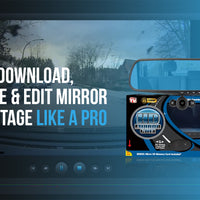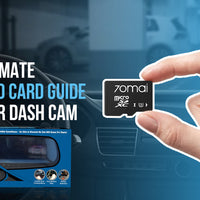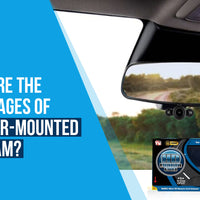A dash cam is a valuable tool that has become an essential gadget and a must-have product for every car now. It is crucial to install a car dash cam as it provides video evidence in the event of accidents and even captures unexpected road moments. Installing a dash cam might be daunting, but it's essential to replace the dash cam with an old-quality cam promptly.

Let's start with a little preparation through the complete guidance of each step on how you can install a dash cam without going to an installer.
Before You Begin
Choose Your Dash Cam: There are many dash cams available, with varying features and price points. Consider factors like video resolution, field of view, night vision capabilities, and storage options before making your purchase.Gather Your Tools: You'll likely need a microfiber cloth, cable clips, a trim removal tool (optional), and possibly a hardwire kit (for a more permanent power source). These can often be found bundled with the dash cam itself.
To install a dash cam, you'll need the following tools and materials:
- Dashcam with these accessories (mount, power cable, etc.)
- MicroSD card
- Trim removal tool
- Cable clips or adhesive cable mounts
- Power source
- Electrical tape or zip ties
- ER manual for your specific dash cam mode
Step-by-Step Installation Guide
Step 1: Choose the Right Dash Cam
Choose a dash according to your needs that may include these features:
- Video resolution (1080p, 1440p, 4K)
- Field of view (angle of the camera lens)
- Night vision capability
- GPS tracking
- Wi-Fi connectivity
- Parking mode
Step 2: Plan the Installation
Determine the exact location for your dash cam, but it should be placed behind the rearview mirror to avoid obstructing your view.
Step 3: Prepare the Dash Cam
Insert the MicroSD card into the dash cam by following the manufacturer's instructions.
Step 4: Prepare the Mount
Most dash cams come with an adhesive mount or suction cup, so it's better to remove protective backing.
Step 5: Mount the Dash Cam
First, adjust the dash cam to the mount. Then, gradually adjust the angle so that it shows a clear view of the road from the camera.
Step 6: Route the Power Cable
The power cable needs to be routed from the dash cam to the power source. This can be done by using 2 ways:
Tuck the Cable
- Take a start by tucking the cable into the headliner.
- Push the cable into the gaps along the headliner by using the trim tool.
Route to Power Source
- Using the Cigarette Lighter Socket: Continue routing down the cable for a cigarette lighter socket
- Hardwiring to the Fuse Box: This method provides constant power with a cleaner look even when your car is parked. Route the cable to the fuse box that is located under the dashboard on the driver's side.
How to Install a Car Dash Cam: Step-by-Step Installation Guide
Installing a dash cam in your car is a smart move for enhancing your driving safety, recording incidents, and providing evidence in case of accidents. This step-by-step guide will walk you through the entire process of installing a car dash cam, ensuring a clean, professional-looking setup.
Why Install a Dash Cam?
Before diving into the installation process, it's important to understand the benefits of having a dashcam dashcam:
- Accident Evidence: A dash cam records everything that happens on the road, providing crucial evidence in case of an accident.
- Insurance Claims: The recorded footage can simplify the process of making insurance claims and proving fault.
- Security: Dash cams often come with parking mode, which records footage even when the car is parked, helping to deter theft and vandalism.
- Driving Habits: Reviewing footage can help improve your driving habits and ensure better safety practices.
Tools and Materials Needed

To install a dash cam, you'll need the following tools and materials:
- Dashcam with necessary accessories (mount, power cable, etc.)
- MicroSD card (if not included with the dash cam)
- Pry tool or trim removal tool.
- Cable clips or adhesive cable mounts
- A power source (usually the car's cigarette lighter socket or a hardwiring kit)
- Electrical tape or zip ties
- User manual for your specific dash cam model
Step-by-Step Installation Guide
Step 1: Choose the Right Dash Cam
Select a dash cam that suits your needs. Some features to consider include:
- Video resolution (1080p, 1440p, 4K)
- Field of view (angle of the camera lens)
- Night vision capability
- GPS tracking
- Wi-Fi connectivity
- Parking mode
Step 2: Plan the Installation
Determine the optimal location for your dash cam. Ideally, it should be mounted behind the rearview mirror to avoid obstructing your view. Make sure the lens has an unobstructed view of the road.
Step 3: Prepare the Dash Cam
Insert the MicroSD card into the dash cam. Format the card if necessary, following the manufacturer's instructions.
Step 4: Attach the Mount
Most dash cams come with a suction cup mount or an adhesive mount. Here's how to attach each type:
- Suction Cup Mount:
- Clean the windshield where you plan to attach the mount.
- Press the suction cup firmly against the windshield.
- Lock the suction mechanism (usually by twisting or flipping a lever).
- Adhesive Mount:
- Clean the windshield area where the mount will be attached.
- Peel off the protective film from the adhesive pad.
- Press the mount firmly against the windshield and hold for a few seconds to ensure a secure bond.
Step 5: Mount the Dash Cam
Attach the dash cam to the mount. Adjust the angle to ensure the camera has a clear view of the road. Most dash cams allow you to adjust the lens angle even after installation.
Step 6: Route the Power Source
The power cable needs to be routed from the dash cam to the power source. This can be done discreetly by tucking the cable along the edges of the windshield and interior panels.
- Tuck the Cable:
- Start by tucking the cable into the headliner (the fabric-covered panel above the windshield).
- Use a pry tool or trim removal tool to gently push the cable into the gaps along the headliner, A-pillar (the vertical post between the windshield and the front door), and door seals.
- Route to Power Source:
- For the cigarette lighter socket: Continue routing the cable down the A-pillar, along the edge of the dashboard, and towards the cigarette lighter socket.
- For hardwiring: Route the cable to the fuse box, typically located under the dashboard on the driver's side.
Step 7: Connect the Power Cable
Cigarette Lighter Socket:
- Plug the power cable into the dash cam.
- Plug the other end into the cigarette lighter socket.
- Turn on your car to check if the dash cam powers on and starts recording.
Hardwiring Kit:
- Locate the fuse box.
- Use an add-on fuse kit to tap into the fuse box, connecting the power cable to the fuse tap.
- Connect the ground wire to a metal grounding point in the car.
- Plug the power cable into the dash cam.
- Turn on your car to ensure the dash cam powers on and starts recording.
Step 8: Secure the Cables
Use cable clips, adhesive mounts, electrical tape, or zip ties to secure the power cable along the routing path. This ensures the cable remains in place and doesn't interfere with your driving or interior aesthetics.
Step 9: Test the Dash Cam
Once wired, use the voltage tester to confirm the proper connection. Turn on your car and ensure the dash cam powers up and starts recording. Check the footage to ensure the camera angle is correct and the video quality meets your expectations.
Step 10: Adjust Settings
Access the dash cam settings to configure preferences such as:
- Video resolution
- Loop recording duration
- Date and time settings
- G-sensor sensitivity (for detecting collisions)
- Parking mode setting
Step 11: Regular Maintenance
To ensure optimal performance, perform regular maintenance on your dash cam:
- Check and Format the MicroSD Card: Regularly check the MicroSD card for any errors and format it according to the manufacturer's recommendations.
- Update Firmware: Check for firmware updates from the dash cam manufacturer and install them to benefit from new features and improvements.
- Clean the Lens: Keep the camera lens clean to ensure clear video footage..
Congrats! Now you are all done!
Installing a dash cam is a straightforward process. Still, after installing a dash cam, you can capture valuable video evidence on the road that can significantly enhance your driving safety and security. By following this step-by-step guide, you can ensure a clean and professional installation. Remember to choose a high-quality dash cam, plan your installation carefully, and maintain the device regularly for the best performance. With a dash cam in place, you'll have peace of mind knowing that you have a reliable witness on the road. Happy and safe travels!






